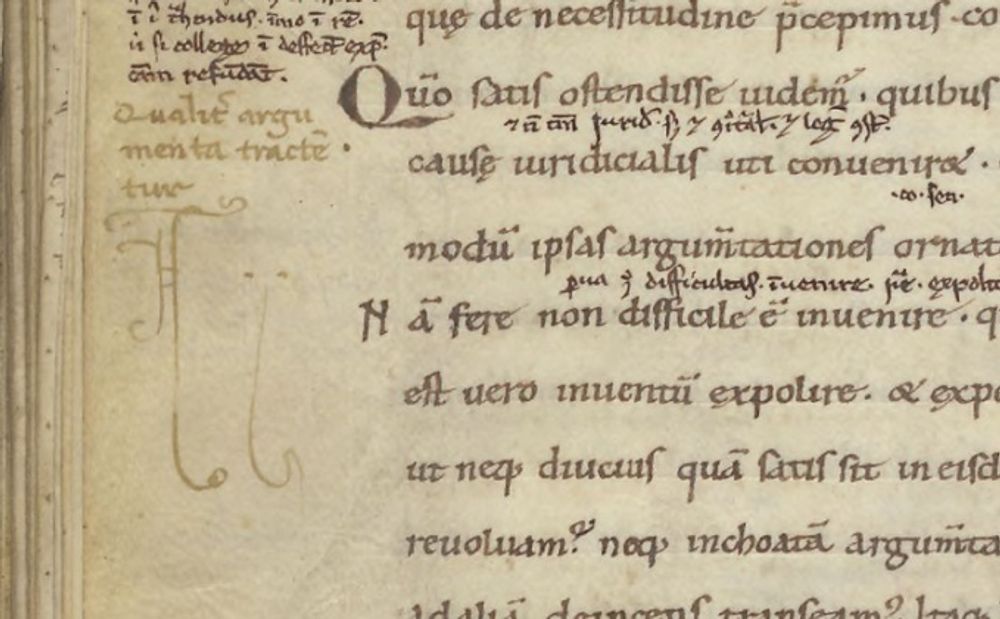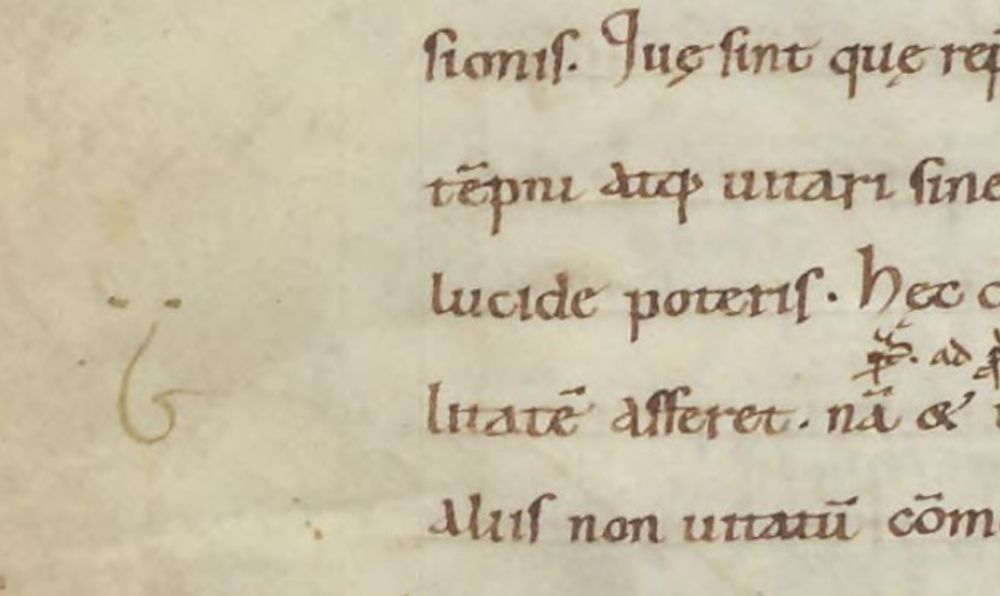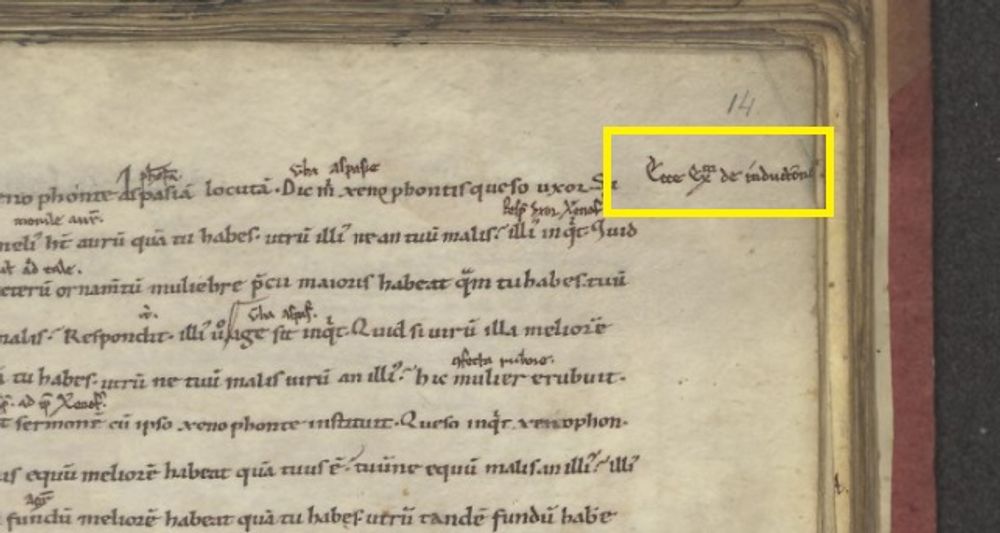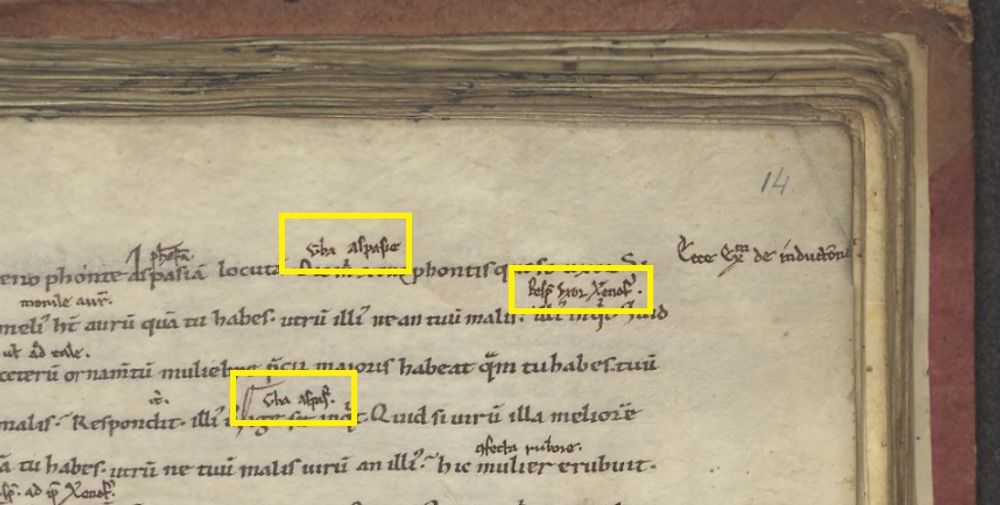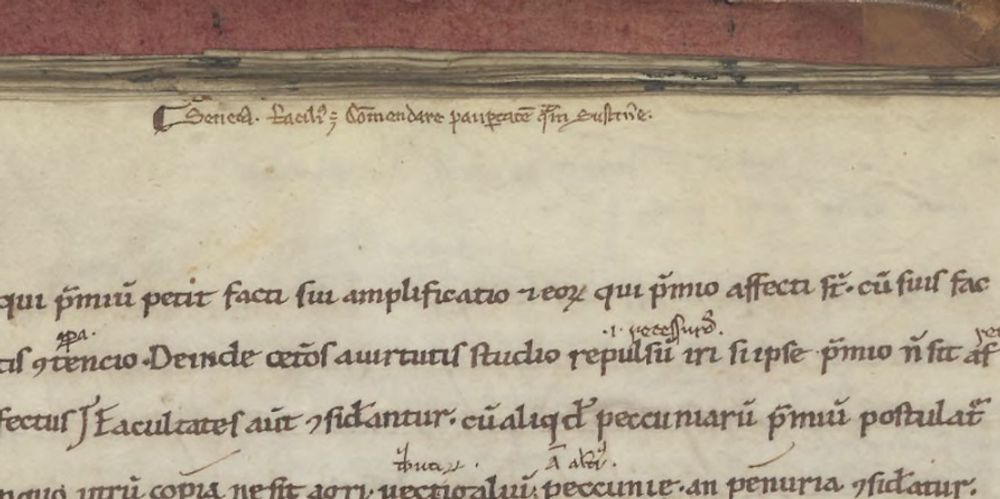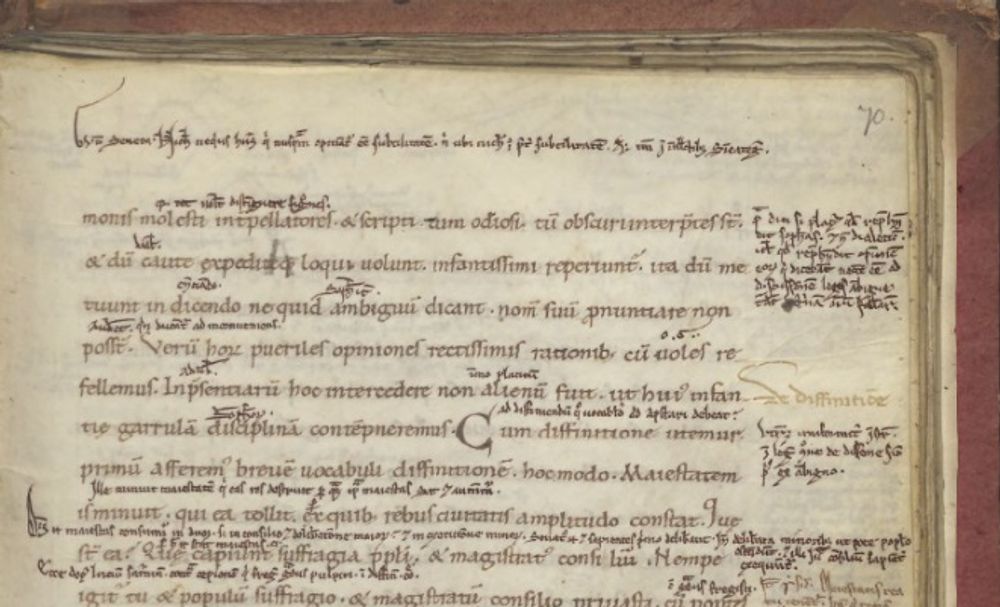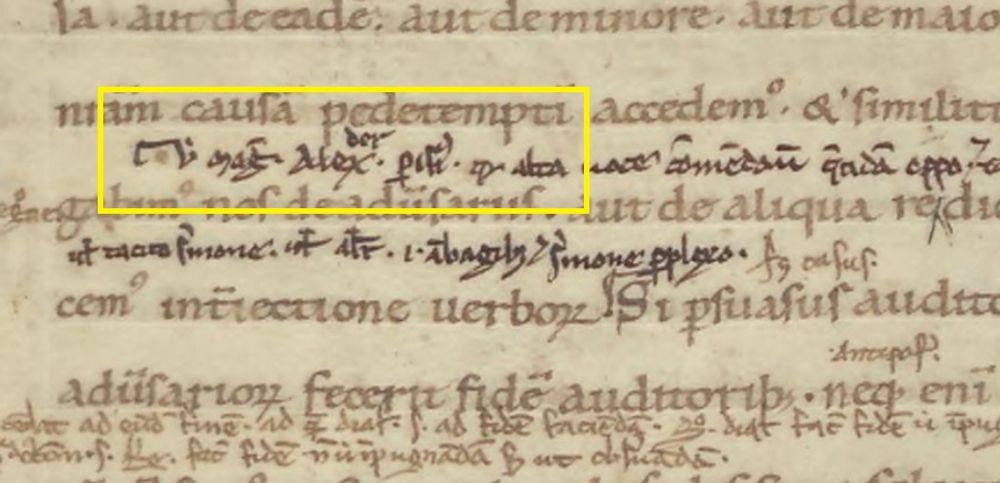Leiden, UB, GRO 22
Introduction1
Leiden, UB, GRO 22 is a twelfth-century French manuscript which was extensively annotated by a number of thirteenth-century readers. The manuscript is a collection of rhetorical texts, containing Cicero’s De inventione (ff. 1r-50v), the apocryphal Letter of Alexander to Aristotle (ff. 50v-55v), and the pseudo-Ciceronian Rhetorica ad Herennium (ff. 59r-112v).
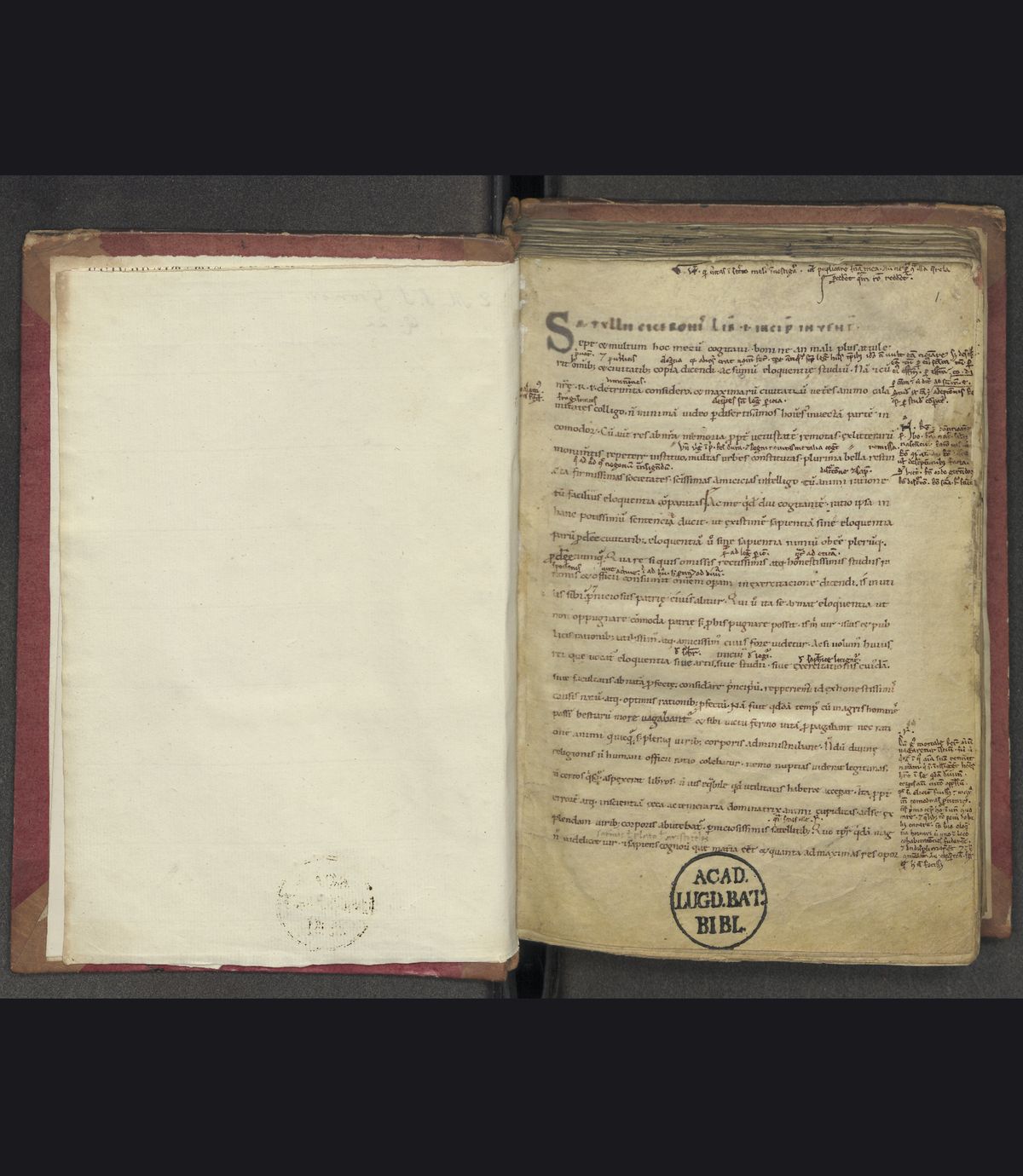

Multiple hands, multiple glossators
As the variation in colours of ink and letter forms suggest, this manuscript was annotated by multiple scribes.
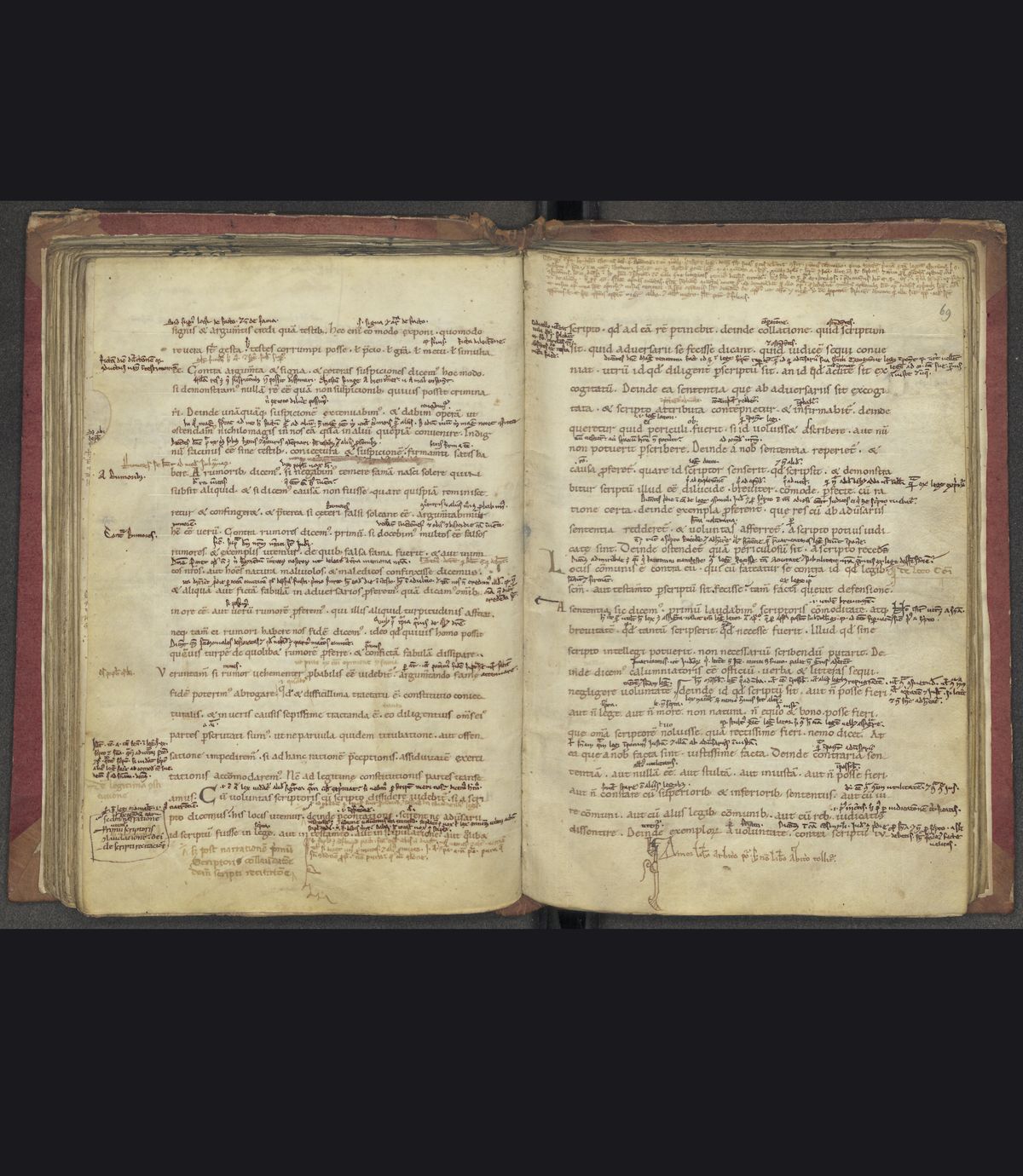

Some scribes even highlighted passages of gloss and text with cartoons of faces! The fact that the annotations here were added substantially later than the point at which the manuscript was copied shows that manuscripts could remain in continuous use long after they were first written. This indicates how precious they were, particularly to teachers and students who may have struggled financially to buy new copies of texts.
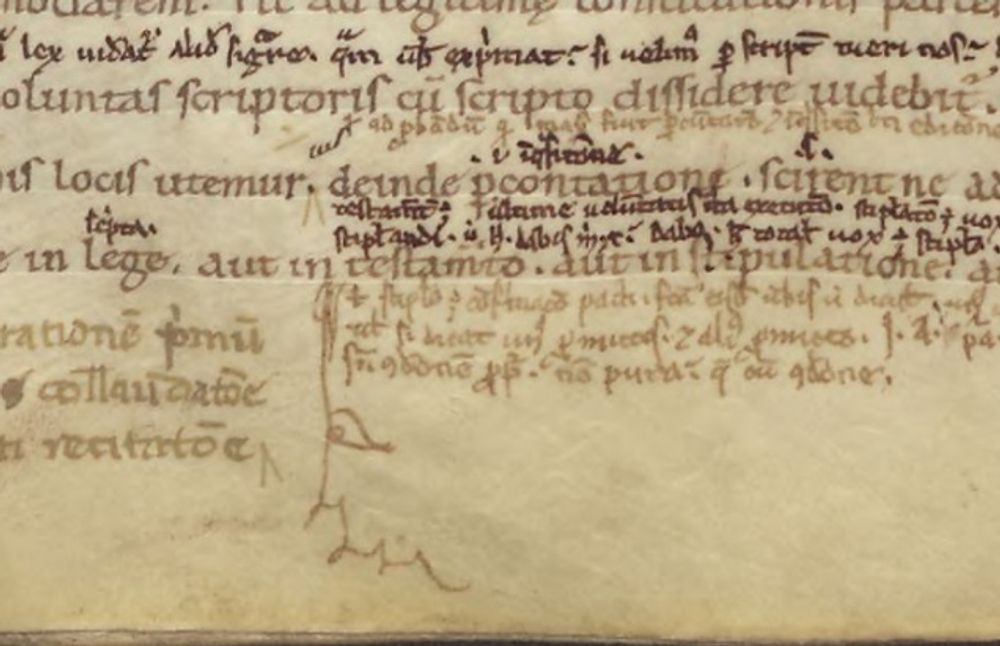

http://hdl.handle.net/1887.1/item:1668135
Gloss as guide
The glossators added comments to almost every page. Over this opening (ff. 13v-14r) they explore the example Cicero used to explain argumentation by induction (when one tries to prove a case which depends on disputed grounds by reference to undisputed facts).
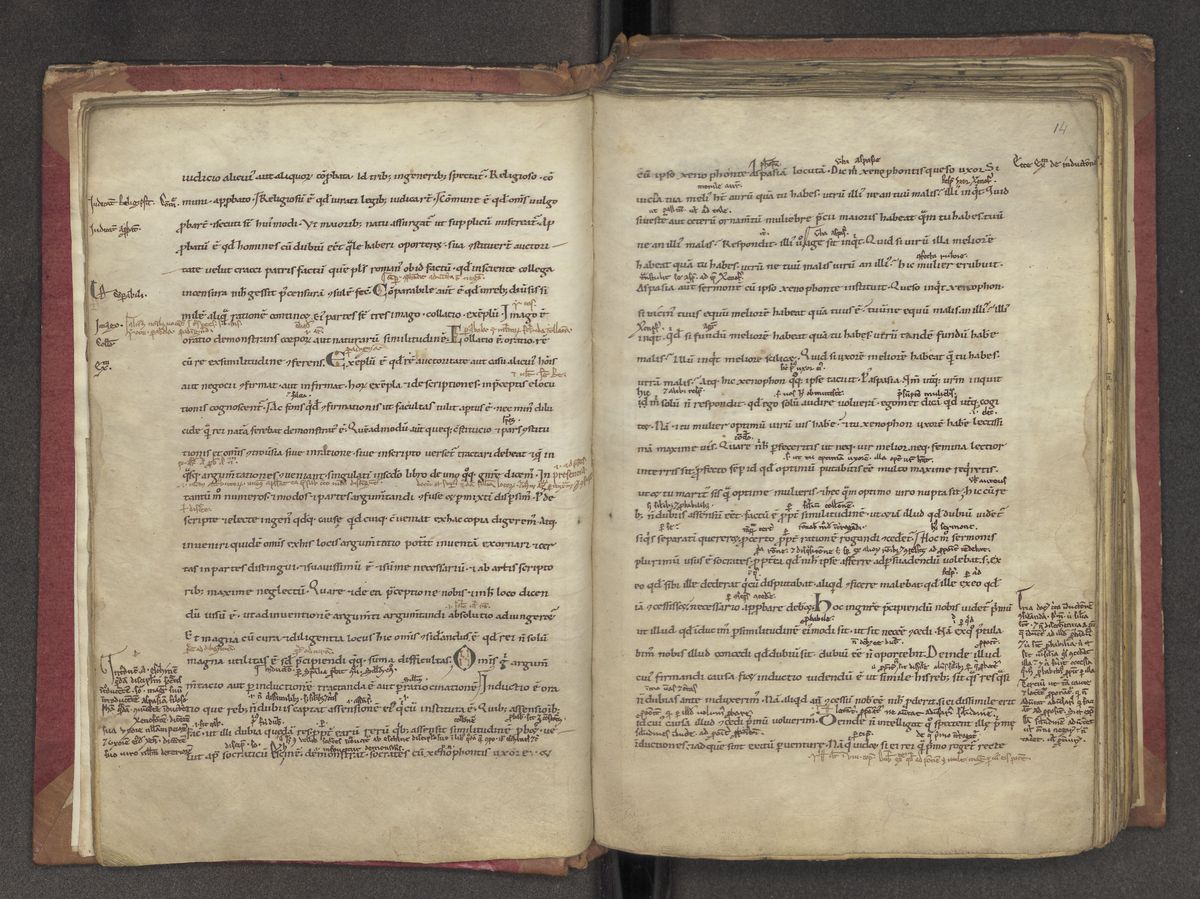

Cicero describes (De inventione I.XXXI.51-3) a conversation between Aspasia, a noted Greek female conversationalist, the philosopher Xenophon, and Xenophon’s wife. Aspasia asks Xenophon’s wife whether she would prefer to have her neighbour’s jewellery, if it was nicer than hers. Xenophon’s wife agrees that she would (an undisputed fact). Aspasia then concludes, applying the rules of induction, that Xenophon’s wife would also prefer to have her neighbour’s husband if he was nicer than hers! Xenophon’s wife can only blush in response...
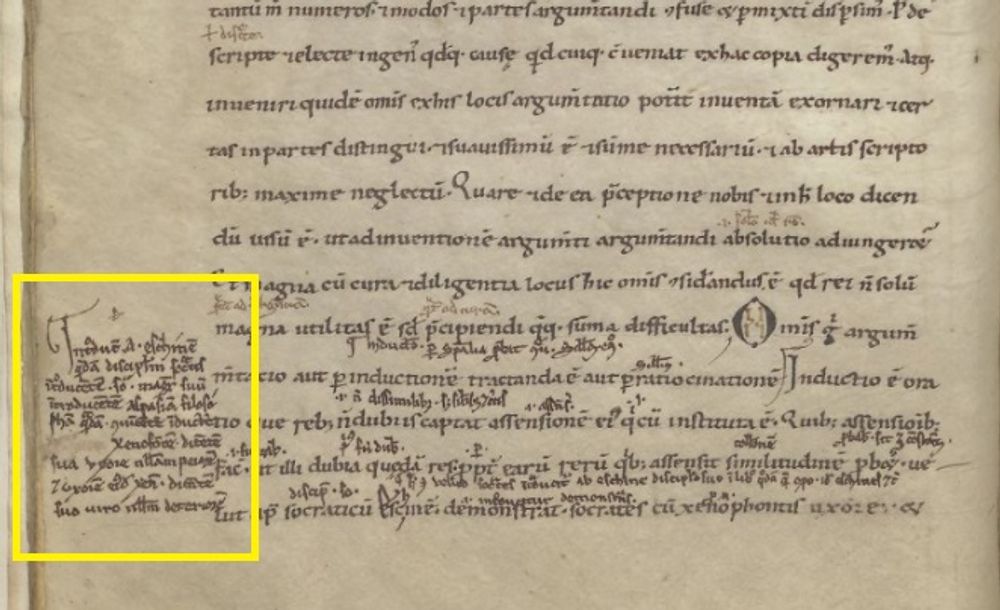

http://hdl.handle.net/1887.1/item:1668135
Glossing with diagrams
Mortal beings, according to Cicero, are defined by features like their sex, their age, their place of origin. In the text Cicero describes how one could be Greek or barbarian, from Athens or from Lacedaemon. The glossator personalises these examples in a scheme – one could be English or French, from York or from London. As Peter Gumbert has argued, these references to English place names may suggest that this glossator also came from England. These schemata in the upper margin summarise Cicero’s discussion of the aspects of human nature (De inventione, I.XXIV.35) which are used to describe people involved in a case.


http://hdl.handle.net/1887.1/item:1668135
Overleaf (f. 11v) the glossator summarises the attributes of action, used to describe what happened in a case. The lengthy list of attributes (De inventione, I.XXVI.37), which include aspects such as the time of an act (whether it happened in the past, in the present, or will happen in the future), was probably transformed into a diagram to facilitate memorisation and provide an overview of Cicero’s discussion. Note how, to the left, the scheme has been expanded by another glossator writing in a lighter coloured ink.
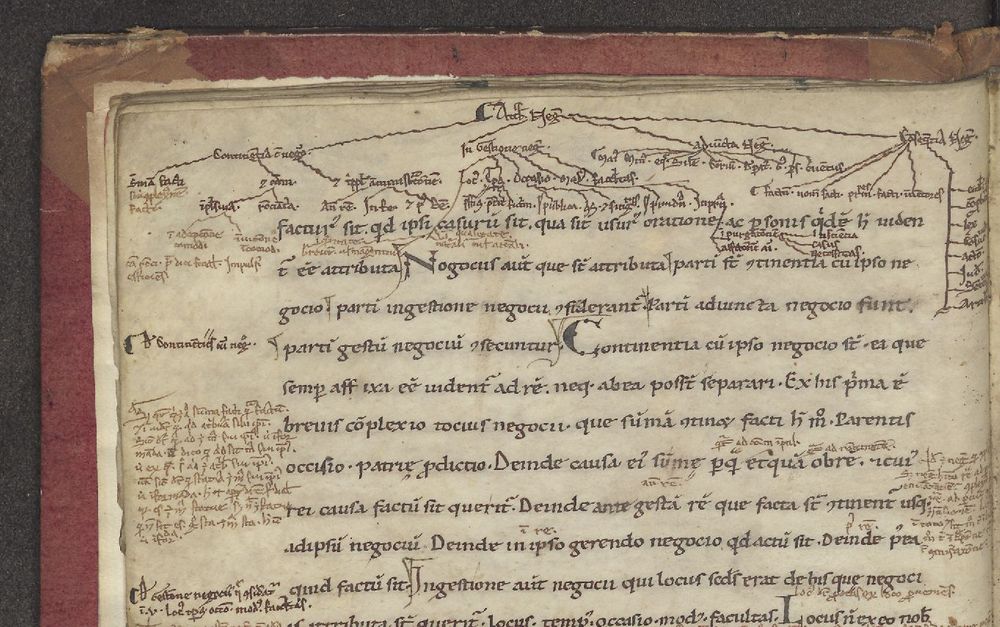
http://hdl.handle.net/1887.1/item:1668135
Looking to the antique past
The glossators used the rhetorical texts as a sort of springboard into the classics, adding quotations from antique authors in the margin whenever possible. Often giving moral advice, these quotations were probably added from memory.
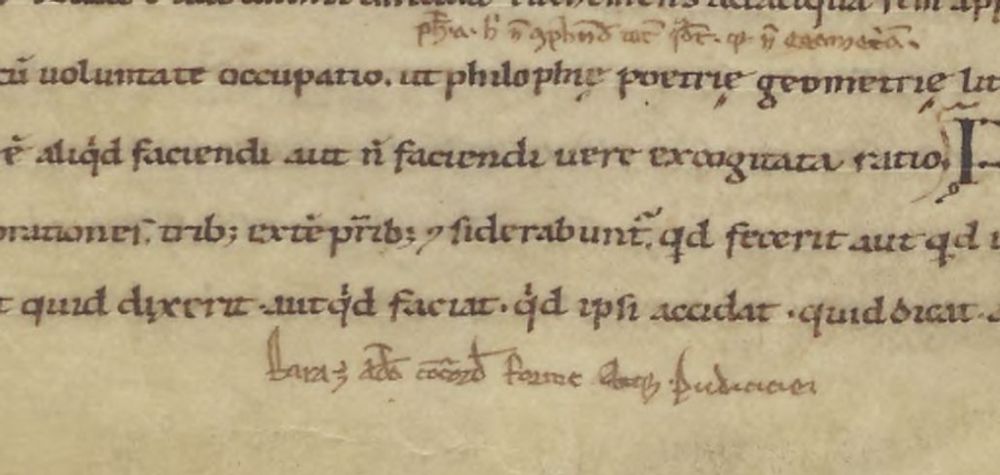

http://hdl.handle.net/1887.1/item:1668135
Looking to the early Christian past
Moral lessons from Christian sources were also integrated into the gloss. Here Cicero discusses how to arouse pity in an audience (De inventione, I.LV.106), writing that the misfortune of another will provoke the listener to contemplate his own weaknesses. The glossator adds a quote in the margin attributed to Augustine (but actually by Gregory the Great) beginning with the words “Bonarum mentium est ibi culpam agnoscere, ubi culpa non est…”, “For good minds acknowledge sin even where there is no sin…”. The fact that the gloss is incorrectly attributed suggests, again, that the glossator was quoting from memory.
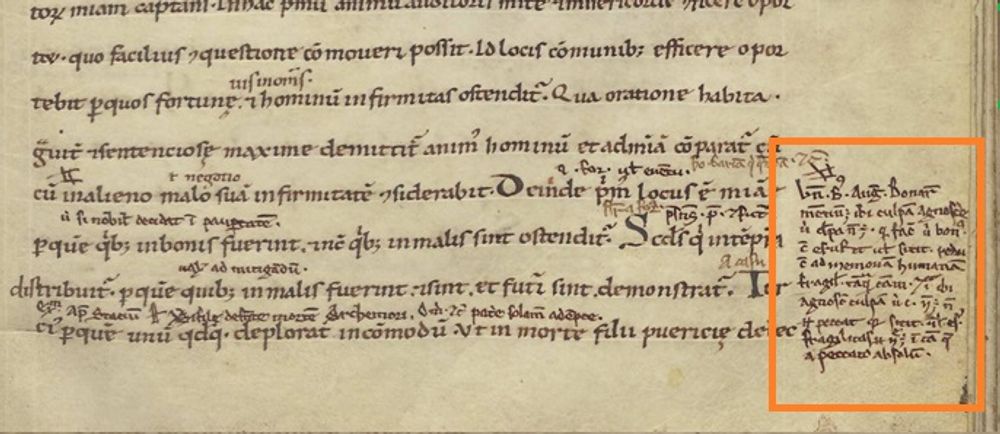
http://hdl.handle.net/1887.1/item:1668135
On f. 58v, a glossator has added Augustine’s list of the eight categories of lies (De mendacio, 25). Rhetorical argumentation concerned the truth in a case, so the question of what constituted a lie, as well as the punishment which different ‘grades’ of lies might deserve, was highly relevant.
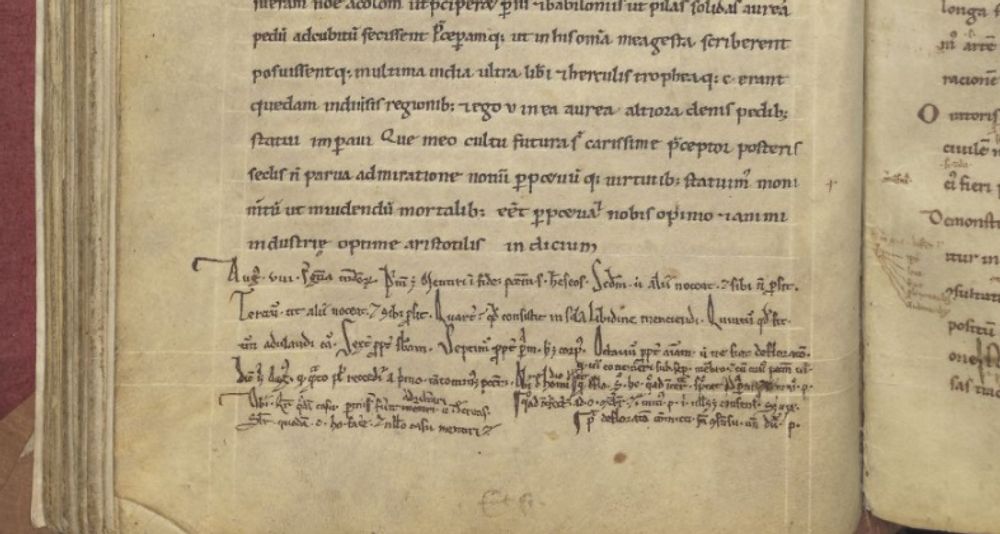
http://hdl.handle.net/1887.1/item:1668135
Looking to the present
As well as these references to figures from antiquity and early Christianity, the glossators also referred to contemporary teachers. But in the absence of more details, these teachers are hard to identify. Who is “Magister Iohannes de P[arvi?] ponte”, referred to on f. 25r? Was he, like Adamus Parvipontus, a master who taught on the petit pont in Paris? And who is Magister Alexander, referred to in a gloss to the Rhetorica ad Herennium (f. 61r)?
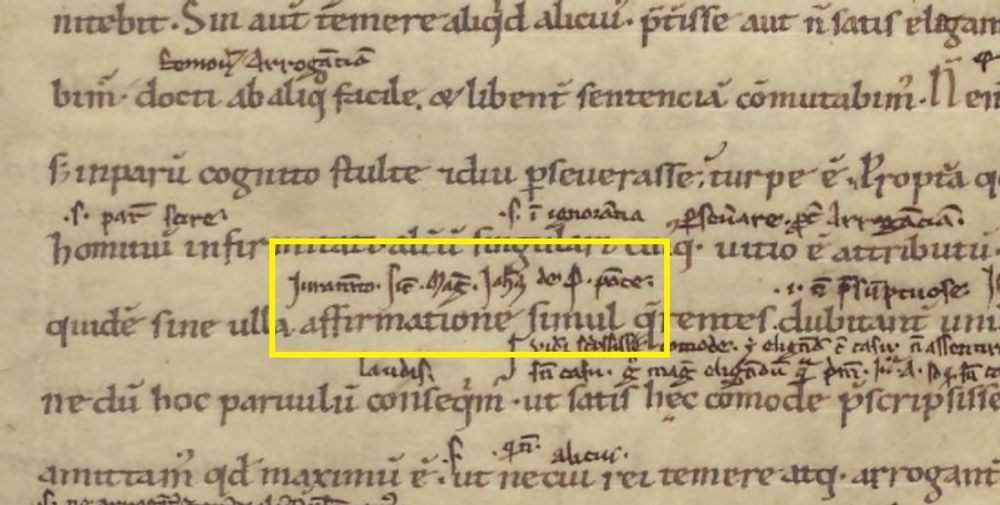

http://hdl.handle.net/1887.1/item:1668135
Rhetoric in the thirteenth century
The amount of annotations added to the pseudo-Ciceronian Rhetorica ad Herennium in Leiden, UB GRO 22 reflects the growing popularity of this text (at the expense of De inventione) in the thirteenth century. Although medieval court procedures were very different to the late antique ones described by Cicero and the anonymous author of the Rhetorica ad Herennium, glossators were clearly interested in what these writers had to say about law and justice. In the margin of f. 70v types of law are schematised to the left, with the parts of justice presented in a diagram to the right. Thirteenth-century advocates, working in increasingly bureaucratised settings, received rhetorical training, even if it was of little practical use in the courtroom.

http://hdl.handle.net/1887.1/item:1668135
Another reason for the continued popularity of the Rhetorica ad Herennium was its comprehensive treatment of the figures of diction and thought, essential for adding stylistic flourishes to oratory. Many copies, including Leiden, UB, GRO 22, split the fourth book of the text into three. Here (f. 95r) we see the start of the ‘fifth’ book which begins with the first figure of diction, repetition.

http://hdl.handle.net/1887.1/item:1668135
Textual Combinations
The Letter of Alexander to Aristotle (ff. 50v-55v), an apocryphal text that is sandwiched between De inventione and the Rhetorica ad Herennium in Leiden, UB GRO 22, is a curiosity. Purporting to be by Alexander the Great (356-323 BC), it describes the author’s journey to the East, complete with encounters with fantastic animals and people. Although this text was widely read, providing a tantalising vision of a world beyond the reach of the medieval reader, it is striking that it is the one part of this manuscript which is hardly glossed. It was probably added between the two texts to use up parchment at the end of De inventione. If we can judge engagement by the intensity of gloss, this text seems to have been of no interest to our studious medieval rhetoricians. Of course, that does not mean that it was not read or enjoyed but, at least, not with a pen in hand.
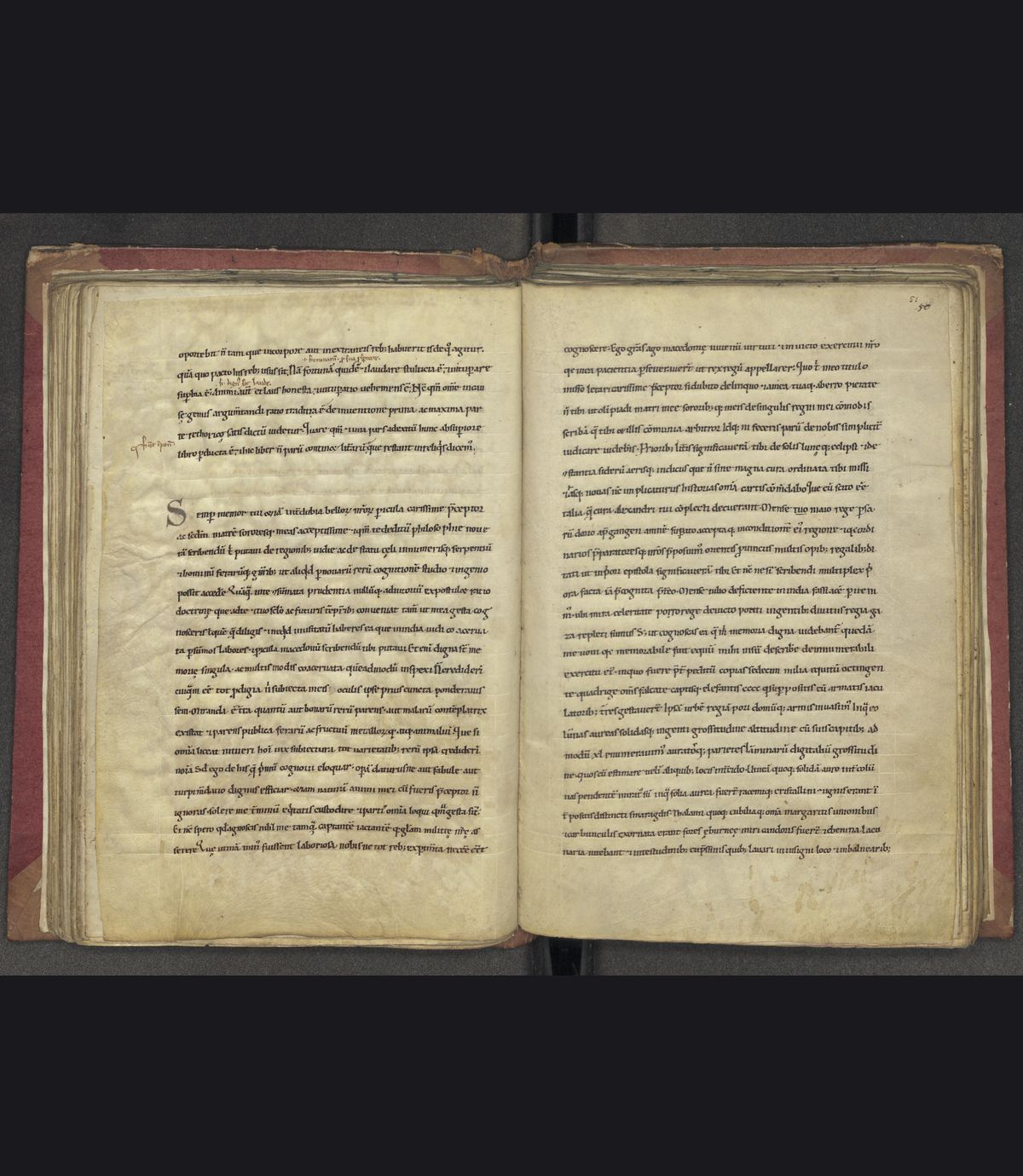

Sources used for this contribution:
- Camargo, M., ‘Latin composition textbooks and Ad Herennium glossing: The missing link?’, in V. Cox and J. Ward (eds), The Rhetoric of Cicero in its Medieval and Early Renaissance Commentary (Leiden, Brill, 2006), pp. 267-88
- Cicero, De inventione, De optimo genere oratorum, Topica trans. H. M. Hubbell (LCL, 386; Cambridge MA, Harvard University Press, 1949)
- Gumbert, J. P., ‘Cicerones Leidenses’, in C. A. Chavannes-Mazel and M. M. Smith (eds) Medieval Manuscripts of the Latin Classics: Production and Use (Leiden: Anderson-Lovelace and the Red Gull Press, 1996), 209-44
- Seneca the Elder. Declamations, Volume I: Controversiae, Books 1-6. Translated by Michael Winterbottom. Loeb Classical Library 463. Cambridge, MA: Harvard University Press, 1974
- Ward, J. O., Classical rhetoric in the Middle Ages: The medieval rhetors and their art, 400-1300, with manuscript survey to 1500 CE (Leiden, Brill, 2019)
Contribution by Irene O’Daly.
Cite as, Irene O’Daly, “Leiden, UB, GRO 22”, The art of reasoning in medieval manuscripts (Dec 2020), https://art-of-reasoning.huygens.knaw.nl/gro22. ↑


